Today’s post is all about one of the most simple, yet substantial, additions you can create in your kitchen to elevate your bowl of homemade ramen – the famous and delicious ramen egg. Ramen eggs, called ajitsuke tamago or ajitama, are soy sauce flavored eggs used as a topping for ramen noodles. They are so delicious they can transform a simple bowl of ramen noodles into something much more luxurious. It’s one of Japan’s most popular ramen toppings and can be made in your kitchen with just 5 ingredients!
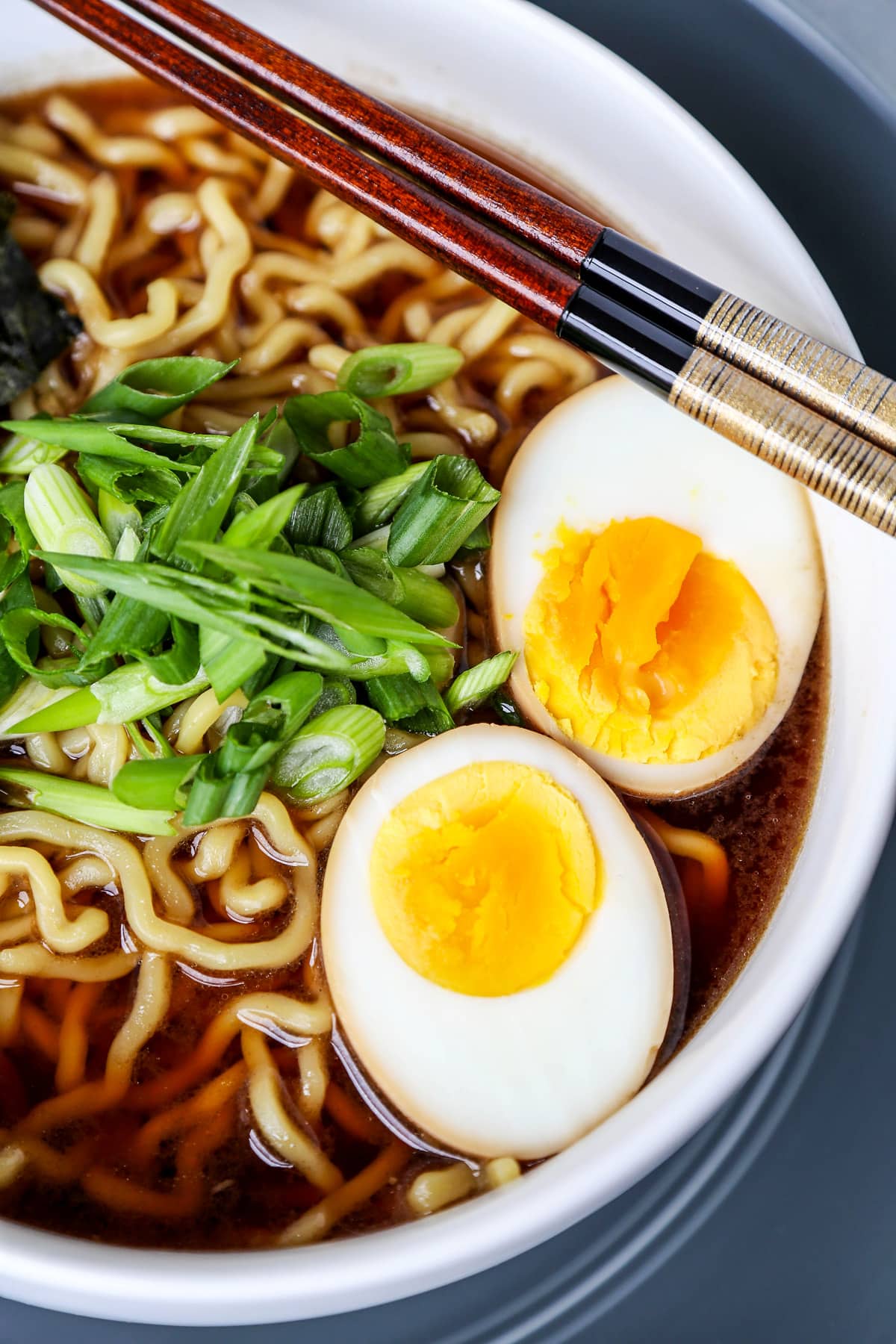
What is a Ramen Egg?
Ramen egg, called ajitsuke tamago (味付け玉子) or ajitama (味玉) in Japanese (which literally means “seasoned egg”), or simply soy egg (shoyu tamago in Japanese), are savory soft-boiled eggs marinated in a combination of soy sauce, mirin or sugar, and sometimes sake. The eggs are typically sliced in half and used as a topping for bowls of ramen just prior to serving. They can also be served medium or hard boiled.
Ramen eggs can also be used as a topping for rice dishes or eaten on their own as a snack or a side.
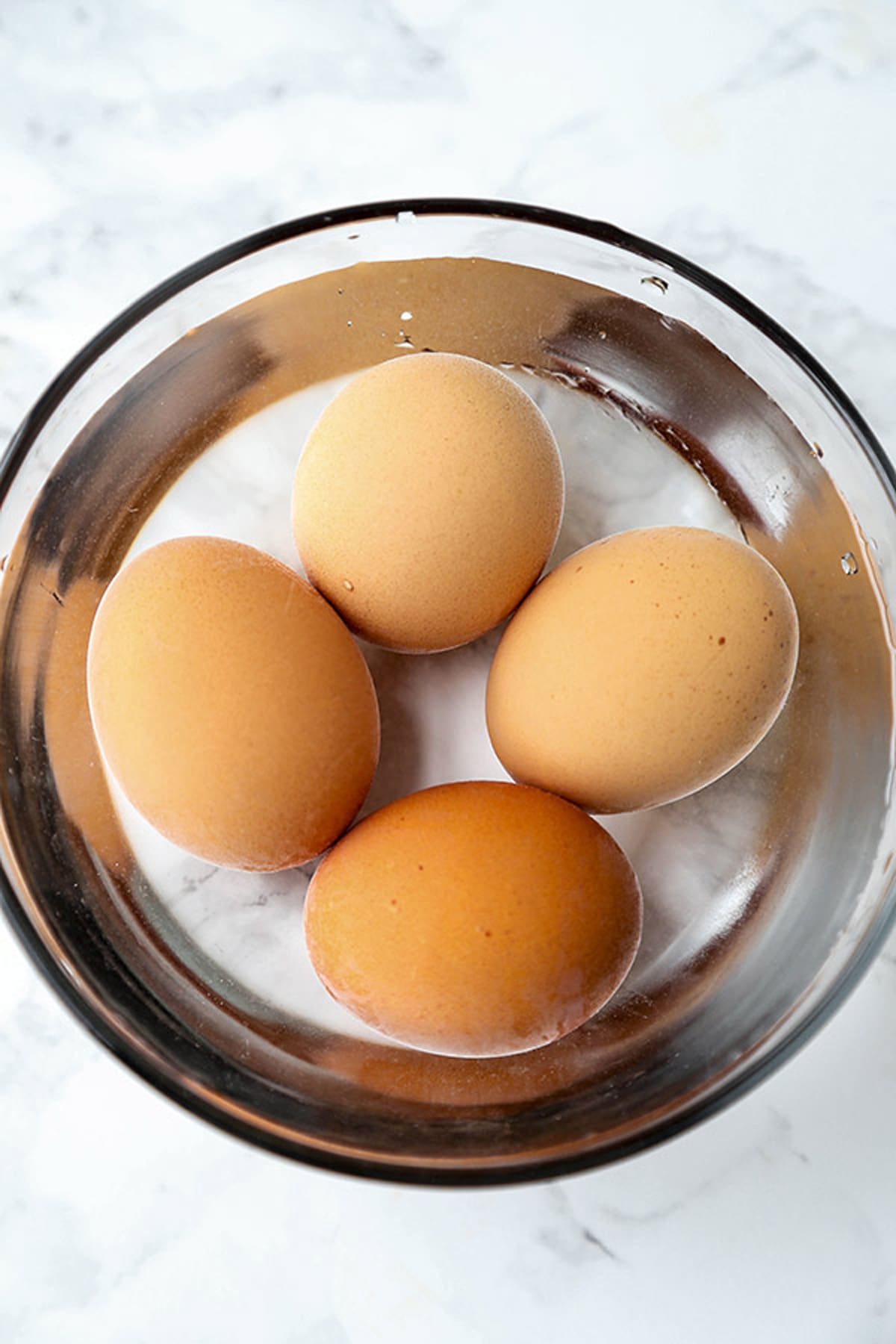
Ingredients for Japanese Ramen Eggs
- Eggs: You will need 4 to 6 large fresh eggs, preferably pasture raised. I recommend pasture raised because they taste significantly better and are easy to find these days. I get mine at Whole Foods.
- Soy Sauce: Make sure to use Japanese soy sauce for this recipe. Japanese soy sauce is quite different than other types of soy sauce because of its level of umami. It’s more complex in flavor while others tend to be either overly sweet or salty. I personally love the Yamasa brand.
- Mirin: Mirin is a type of rice wine that is sweet, earthy, and umami in flavor. Real mirin is fermented and gets its sugar content from that process. Therefore, the flavor or real mirin is much more complex than what is usually sold here in the US. If you can find real mirin (most store bought mirin doesn’t contain alcohol and is made with corn syrup). This Takara mirin sold on Amazon is pretty close to the real deal.
- Sake: Sake adds fruitiness and nuttiness to the eggs. No need to open an expensive bottle of sake for these eggs. Using cooking sake will yield the same result.
- Ground Black Pepper: Totally optional but so good! If you love a little heat with your food, you will love the addition of ground black pepper here.
Alternatives
Mirin Alternative: Use 1 tablespoon granulated sugar instead of 2 tablespoons mirin.
For Gluten-Free Ramen Eggs: Use liquid amino instead of soy sauce. You can try with tamari as well but I find that liquid amino tastes much closer to soy sauce. Also, look at the ingredients list in mirin to make sure it doesn’t contain hydrolyzed vegetable protein (which contains gluten).
For Low-Sodium Ramen Eggs: Instead of using 3 tablespoons soy sauce, use 1 tablespoon soy sauce and 2 tablespoons water. Or try using the Less Sodium Soy Sauce by Kikkoman.

How to Make Ramen Eggs
Scroll all the way down to the recipe card for the full recipe.
- Boil the eggs to your desired consistency. For tips on how to boil egg to perfection, every single time, scroll down for more details. I personally like my soy sauce egg to be somewhere between soft and medium boiled.
- When the eggs are boiled, shock them in a bath of ice cold water immediately. Let them cool for a few minutes.
- Meanwhile, mix the soy sauce, mirin, sake, and ground black pepper in a bowl.
- Peel the eggs and place them in a storage bag or container. Pour the sauce over and let some of the air out of the bag before sealing it. If you are using a container, close it with a lid.
- Refrigerate shoyu eggs for at least 2 to 4 hours, turning the eggs over every 30 minutes or so, so all the sides marinate evenly. I recommend marinating them overnight so that you get a nice strong flavor.
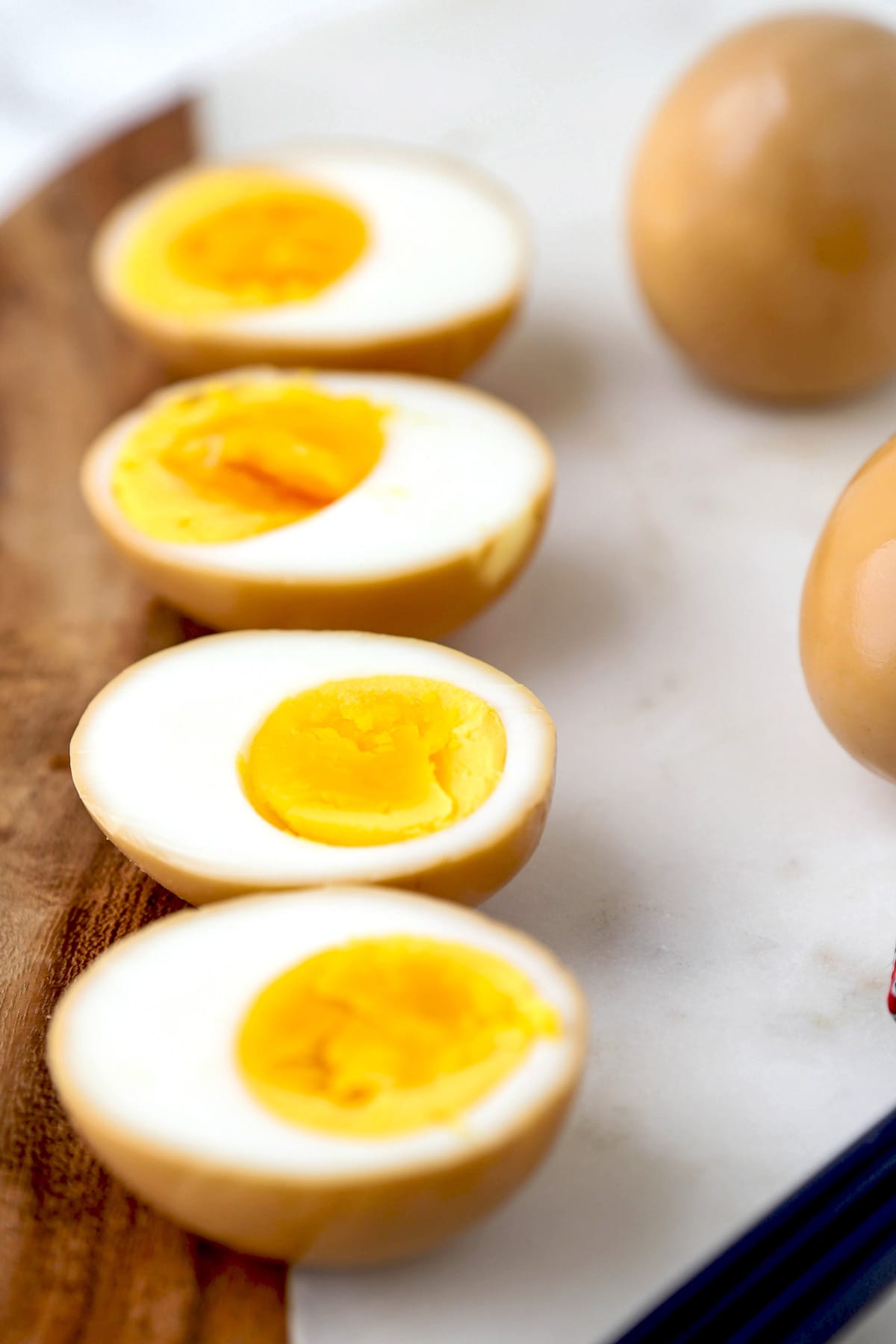
Commonly Asked Questions
What is the longest I can marinate ramen eggs?
Two days. Remember that the longer you let them marinate, the stronger the flavor.
Can I make the marinade in advance?
Yes, you absolutely can. Save the marinade in an airtight container and refrigerate it until it’s time to make the eggs. It should last for up to 6 weeks in the fridge.
What is the best way to peel eggs?
There are two things you can do to help eggs peel more easily:
- Using a needle, carefully and gently prick each egg at the bottom.
- Add 1 tablespoon of vinegar to the pot of water.
Can I reuse the soy sauce marinade?
I don’t recommend saving used marinade as it takes on some of the sulfuric taste of the eggs, which ends up changing the overall flavor of the sauce.
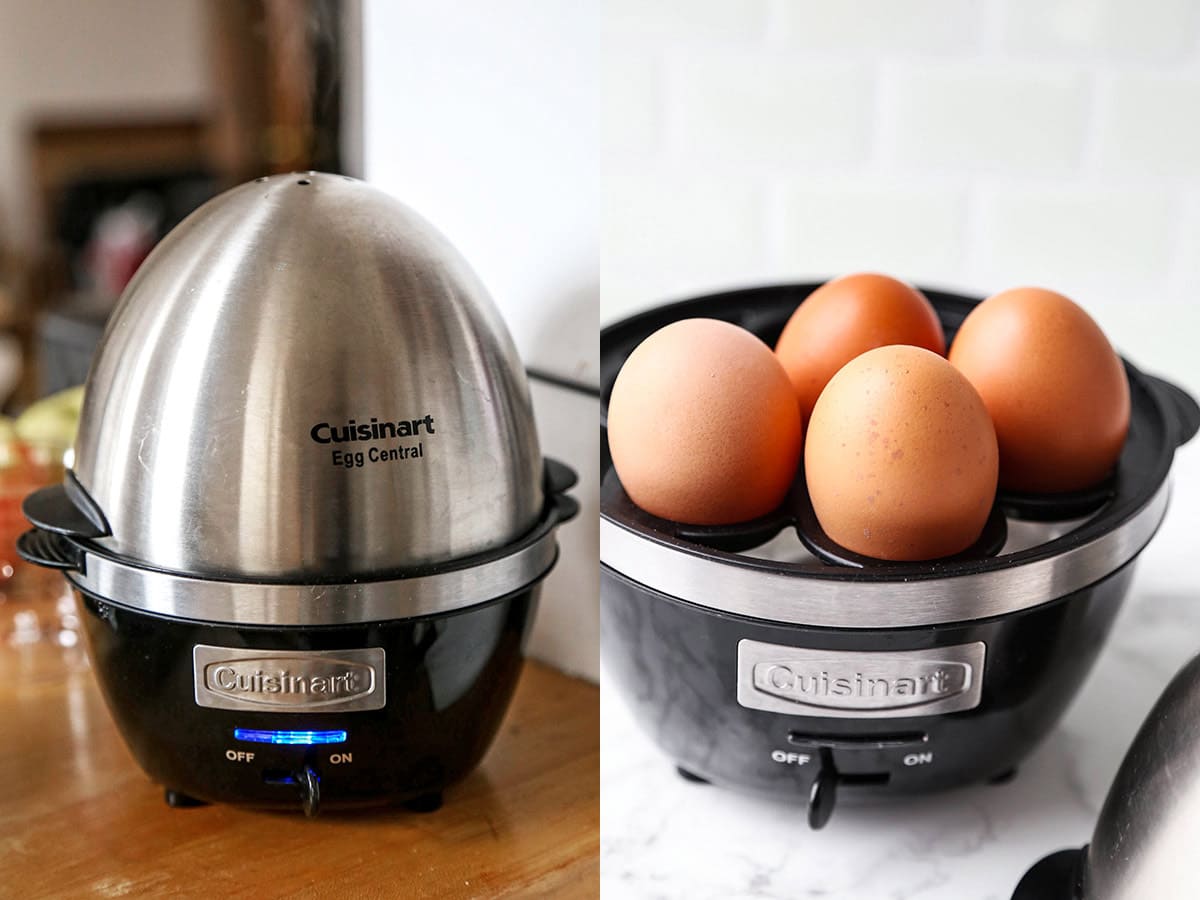
How to Boil Eggs to Perfection Every Single Time
Boiling eggs can seem like such an enigma – because there are a ton of methods out there. And, while techniques can vary significantly, many of them will have you arriving at the exact same place in terms of doneness and yolk consistency.
If you have a method you swear by, stick to it – plain and simple.
Otherwise, get yourself an egg cooker. Seriously. It’s the best invention for making perfect eggs and I promise you will not regret this purchase. I use mine once or twice weekly. It’s my third most used kitchen appliance after my blender and rice cooker.
If you would rather stick to boiling the eggs, I have a really detailed tutorial on how to cook eggs here.
Don’t want to read the tutorial? Here’s the condensed version
- Bring a pot of water and add 1 tablespoon of vinegar. Bring the water to a roiling boil and turn it completely off.
- Add your eggs to the water and place a lid on the pot. Wait for 6-7 minutes.
- Transfer the eggs to ice water or into an ice bath to stops the cooking process. In a pinch you can also run them under cold water.
- Take the shell off and place into the marinade.
Overall, the result is a ramen egg that holds up when I stick it in hot soup. You see, an overdone yolk is chalky. And an underdone yolk will disappear as soon as it hits the soup.
I’m totally aiming for the middle ground: an egg yolk that holds up, yet still delivers on the soft, creaminess I’m craving.

Other Popular Ramen Toppings
While each bowl of ramen is served with a variety of toppings, making each creation unique, there are a few ingredients that seem to appear more often than others, such as ramen eggs. Here are other popular toppings to add to your ramen and that pair well with a ramen egg:
- Chopped green onions (negi). They add a lovely crunch and a pop of color.
- Menma (seasoned bamboo shoots). Menma is a popular Japanese condiment made of fermented bamboo shoots that are seasoned with a mixture of water, soy sauce, and sugar.
- Seaweed (wakame). Seaweed is often used as a topping to add a mineral, briny taste to the dish.
- Roasted seaweed (nori). Just like regular seaweed, nori has a mineral taste and is packed with umami.
- Fish cakes (kamaboko). The most popular type of fish cake used for ramen is the narutomaki, a white fish cake that comes with a pink swirl in the center, and that is chewy in texture.
- Chashu (braised pork belly). Chashu is one of the most popular ramen topping for its melt-in-your-mouth texture, and savory taste.
- Bean sprouts (moyashi). Bean sprouts add a refreshing taste and a satisfying crunch.
- Butter. Butter is often added in ramen dishes from the northern part of Japan, where the winters are known to be quite harsh. The butter adds a comforting element while deepening the flavor of the broth (often miso based).
- Corn. Corn and butter are often paired together because of the lovely combination of sweet, creamy, and salty. Corn is mostly used in ramen dishes from the northern part of Japan.
- Rayu (chili oil). Did you know that most ramen bowls served in Japan come with a flavored oil? That’s what makes the ramen soup so delicious and what gives each shop its own unique taste, since most ramen masters create their own flavored oils (made with shallots, garlic, ginger, etc…). For those of you who like a little heat, try adding a squirt of rayu to your next bowl of ramen.
- Yuzu kosho. Yuzu kosho is a condiment that hails from the southern part of Japan, and where my mother is from – Kyushu. This is also Ben’s go-to ingredient to enhance just about any dish he eats. The condiment consists of yuzu peels, fresh chilis, and salt, that are made into a thick paste. It’s also worth noting that a little goes a long way!
Easy Ramen Recipes to Pair with Ramen Egg:
Ramen Side Dishes:
- Nasu dengaku (Japanese broiled eggplant with sweet miso glaze)
- Kani salad (Japanese crab salad)
- Edamame with soy and sesame sauce
- Japanese fried rice (yakimeshi)
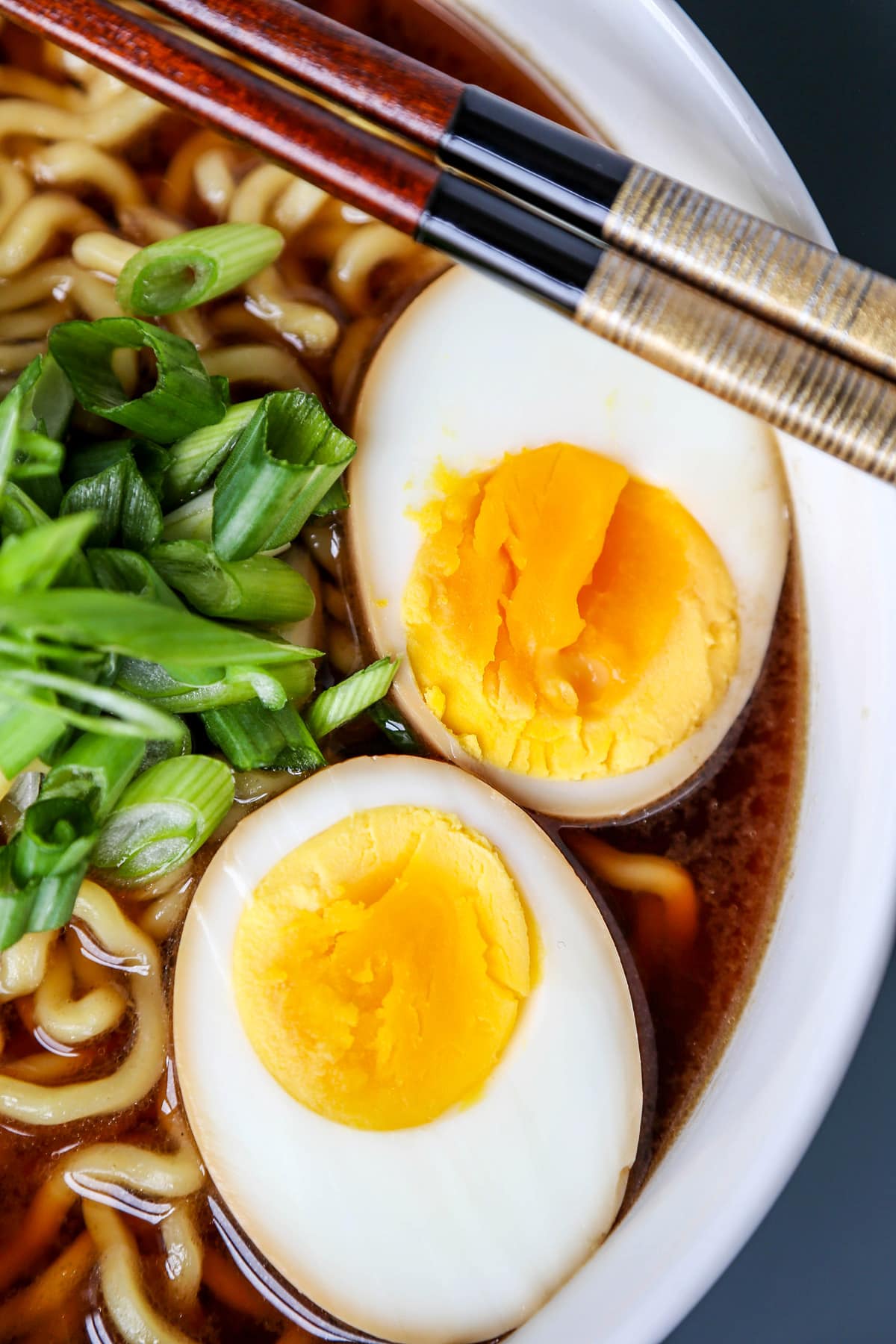
Did you like this ramen eggs recipe? Are there changes you made that you would like to share? Share your tips and recommendations in the comments section below!
Print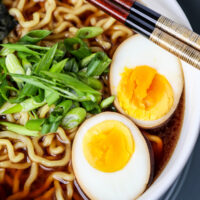
Ramen Eggs (Ajitsuke Tamago)
- Prep Time: 5 minutes
- Cook Time: 6 minutes
- Total Time: 11 minutes
- Yield: 4 to 6 eggs 1x
- Category: Side
- Method: Marinating
- Cuisine: Japanese
Description
Making ajitsuke tamago is very easy! And they are the perfect topping for a hot bowl of ramen noodles.
Ingredients
- 4–6 large eggs
Marinade:
- 3 tablespoons soy sauce
- 2 tablespoons mirin
- 1 tablespoon cooking sake
- pinch ground black pepper
Instructions
- Bring a pot of water to boil and turn the heat off. Carefully add the eggs, cover and let sit for 6-7 minutes until they are soft to medium boil in consistency. If you are using an egg cooker, use the cup the egg cooker comes with and fill it with water up to the medium boil line, or just under for a softer consistency. Put the lid on and start steaming.
- Meanwhile, add the ingredients for the marinade in a bowl and stir. Set aside.
- Once the eggs are cooked, submerge them in a bowl with ice cold water. Let sit for 5 minutes and peel.
- Place the eggs in a Ziploc bag or other sealable container, pour the marinade over and seal. Rotate the eggs every 30 minutes or so, for 2-4 hours. You can let them marinate for up to 2 days for a stronger taste.
- Slice in half and serve with ramen or rice.
Notes
Keep the ramen eggs refrigerated in an airtight storage container. They will keep for up to 1 week.
Nutrition
- Serving Size: 1 egg
- Calories: 82
- Sugar: 0.3g
- Sodium: 81.9mg
- Fat: 4.8g
- Saturated Fat: 1.6g
- Unsaturated Fat: 1g
- Trans Fat: 0g
- Carbohydrates: 0.9g
- Fiber: 0g
- Protein: 6.3g
- Cholesterol: 186mg















The recipe for marinade has 5 stars from me! But unfortunately I have no egg cooker and followed the recipe for making soft eggs. Unfortunately in the end were not the consitency that was suitable for marinating. I had to boil eggs once again. I followed the method when you submerge eggs into cold water, smth like these: https://freefoodtips.com/how-to-make-soft-boiled-eggs-on-the-stove/
But eggs after that sauce were yummy! Easy recipe with so few ingredients!
These have become a huge hit with my son for his school lunch, so much so I am having to do six at a time lol.
One thing I am having trouble with and that is getting an even colour form the marinade, quite often I will have eggs that still have a white patch on them after soaking overnight. Any ideas?
Hi Alex, I’m so glad your son likes them! I would suggest soaking them a couple of hours early before bedtime so you can flip them over every 30 minutes or so to help the color even out. I usually do it in the afternoon and drain the liquid after 5-6 hours since I don’t like them too strong. Keeping an eye on them gives them a nice, uniform color 🙂
Hi! How did you calculate the nutrition value of these ramen eggs? 🙂